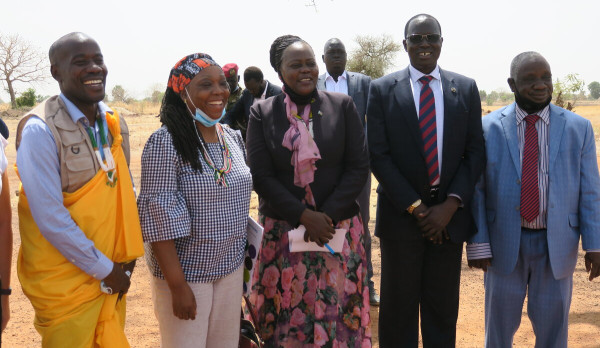UNMISS Deputy Chief and Resident Coordinator announces plans to modernize cultivation scheme in Aweil first launched in 1944

Peace. Partnerships. Progress.
These were the main objectives of the Secretary-General’s Deputy Special Representative and Resident Coordinator for South Sudan, Sara Beysolow Nyanti’s maiden visit to Aweil, Northern Bahr El Ghazal.
And nothing encapsulated them more than her avid interest in the historic Aweil Rice Scheme Project.
What is this Rice Scheme, one might ask?
The answer: A mechanized system that sought to modernize sustainable farming practices by using tractors for preparing and planting farmlands, launched as far back as 1944 by the British.
To call the Rice Scheme forward-looking would be an understatement. But its ambitious inception notwithstanding, the Scheme has run into problems in past years.
“The cost of fuel skyrocketed and spare parts for tractors didn’t come cheap either,” revealed Peter Akon, a representative for the farming community. “The second issue: Farmers weren’t trained to use modern technology, had low knowledge of rice processing techniques and capacity-building opportunities for them were non-existent.”
These and more such challenges that included a lack of seeds led to the Rice Scheme being largely, though not totally, abandoned by local cultivators.
That is, until DSRSG Nyanti, travelled some 20 kilometers from Aweil town, with her delegation, to closely examine this innovative, and now nationally led project under the auspices of the state Ministry of Agriculture and Food Security.
Currently, 750 rice cooperative farmers use 625 hectares of the Rice Scheme, located within the flood plains of the river Lol, while additional hectares are leased to private farming entities.
These numbers do not look like much to the common observer.
But what the UNMISS Deputy Chief saw was incredible potential for food security in a country that has been devastated by perennial conflict and climate change, leading to widespread poverty, displacement, and hunger.
“If we are able to harness its full capacity, the Aweil Rice Scheme can produce some 23,000 metric tons of rice annually,” said DSRSG Nyanti. “That’s enough to feed the entire population of South Sudan and have surplus in stock,” she added.
Assessing the project for rehabilitation was high on the list for local authorities as well.
“We want the Rice Scheme to be rehabilitated and get a fresh start because not only will we be able to lift our own people from the grip of poverty but also help communities across South Sudan,” said Lily Albino Akol, Deputy Minister for Agriculture and Food Security. “The restoration will be a joint effort between my Ministry and the Food and Agriculture Organization, funded by the African Development Bank,” she added.
It's a challenging project and an exciting one. Most importantly, according to the DSRSG, it’s an essential step for South Sudan to forge a prosperous future.
“Right at this very moment, there are 8.9 million people who are hungry across the country. We must do everything in our power to ensure that this dire scenario changes for the better. I, therefore, urge all of you to do your best to double your yields and work collaboratively to restore the rice mill,” said Ms. Nyanti to farmers who gathered to meet her.
Distributed by APO Group on behalf of United Nations Mission in South Sudan (UNMISS).
Get the latest news delivered straight to your inbox every day of the week. Stay informed with the Guardian’s leading coverage of Nigerian and world news, business, technology and sports.






0 Comments
We will review and take appropriate action.